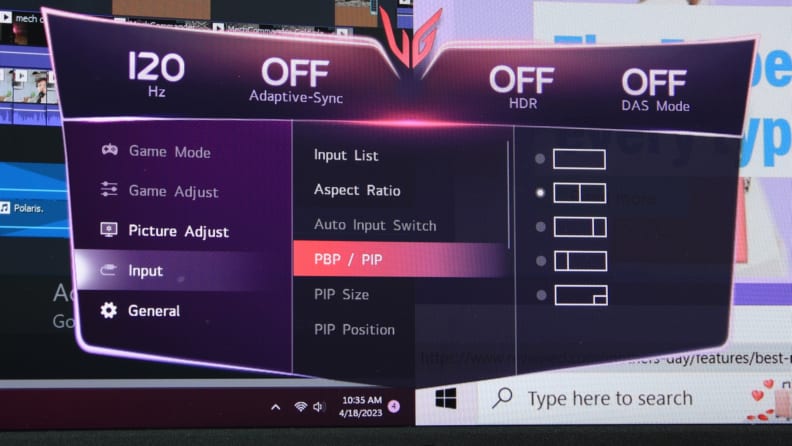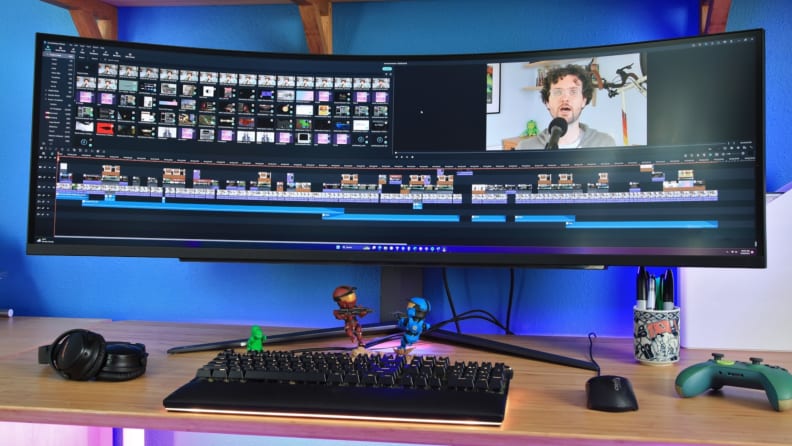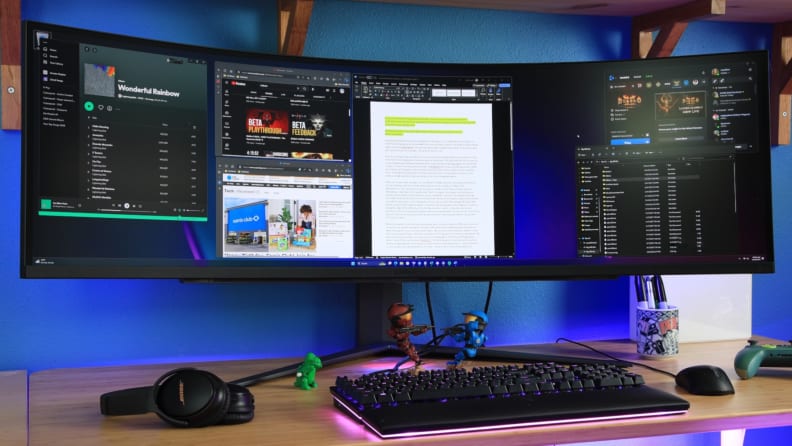Want to browse the web, write in Word, reference a few research documents, keep an eye on Slack, and watch YouTube—all at the same time? If so, you might think that a dual-monitor setup is the way to go.
That would’ve been true a half-decade ago but today, in 2023, there’s a better upgrade: an ultrawide or super-ultrawide monitor. These massive, gorgeous displays provide all the benefits of two monitors in a single seamless display.
A single large display can spoil the window snapping features of Windows 10 and 11, as splitting a massive screen into two, three, or four evenly divided sections can look awkward. Thankfully, this is easily fixed with FancyZones, a utility that lets users customize how and where Windows snaps. It turns the borderless display into an advantage, aligning windows across the seamless display in ways a dual-monitor setup can’t support.
No borders, maximum productivity

Credit:
Reviewed / Matthew S. Smith
Picture-by-picture (PBP) and picture-in-picture (PIP) modes split the display into two monitors for those using two computers.
A super-ultrawide monitor’s biggest perk is its most obvious :it’s huge! The LG Ultragear 49GR85DC-B’s 49-inch, 5120 x 1440 pixel super-ultrawide panel, for example, is a massive expanse of seamless display real estate open for whatever use you choose to throw at it.

LG Ultragear 49GR85DC-B
The 49-inch LG Ultragear 49GR85DC-B fully envelopes players into the game with immersive and vivid gameplay.
A pair of 27-inch monitors placed side-by-side deliver the same combined display space, but with a bezel separating the displays. That’s a problem when using an app across both displays simultaneously. Video editing software is a great example. A dual-monitor setup sticks a border in the middle of the editing timeline, but an ultrawide can display a long, unbroken video editing timeline. Similar benefits apply to editing high-resolution photos or large Excel spreadsheets.
Even a smaller, 34-inch ultrawide like the Alienware AW3423DW or Gigabyte G34WQC-A offer similar benefits. Though not as large as two 27-inch monitors, the lack of a border interrupting programs makes the display feel larger than it is. Either is a great alternative for those looking to pair a 27-inch monitor with a second, smaller display like a 24-inch desktop monitor or 15-inch portable monitor.

Gigabyte G34WQC-A
The 34-inch Gigabyte G34WQC-A has a 21:0 immersive ultrawide aspect ratio and smooth gameplay with AMD FreeSync Premium.
Removing the border between monitors also maximizes versatility. There’s no restriction on how windows can be arranged across the display. It’s possible to resize and move windows into whatever position seems most comfortable while keeping the monitor centered on a desk.
Of course, there are situations that require two displays. Some tasks require more than one PC or Mac and many home office workers use a personal computer alongside an employer-provided laptop. The LG 49GR85DC-B has this covered with a picture-by-picture (PBP) mode that splits the 49-inch display into two monitors. There’s a picture-in-picture (PIP) mode, too: perfect for watching video on the sly. Some 34-inch monitors also pack these features. The Philips 346E2CUAE, which retails for $420, it an affordable entry with PBP/PIP features.

Philips 346E2CUAE
This 34-inch ultrawide has a curved VA panel for wide-viewing angles and a visual experience that envelopes the viewer.
Super-ultrawides shine when it’s time to clock out

Credit:
Reviewed / Matthew S. Smith
Ultrawide monitors are optimal for gaming and movies, offering an immersion that smaller displays just can’t.
The perks of an ultrawide monitor are attractive even if they’re limited to productivity work, but the LG 49GR85DC-B is just as excellent when gaming.
A single huge display is superior to multiple, smaller displays when it’s time to kick back with a PC game. Most aren’t designed to use multiple displays, which means the game can only display on one monitor at a time. There are a few ways to get around this, such as AMD’s Eyefinity, but software support is limited and the bezels between displays will still be visible.
The same is true with movies and other widescreen content. Anything that aims for a cinematic experience will target an aspect ratio wider than the 16:9 aspect ratio of a 27-inch widescreen monitor. This usually leads to letterboxing, which places black bars above and below the film. An ultrawide like the LG 49GR85DC-B, which has a 32:9 aspect ratio, is wide enough to display any movie without letterboxing (smaller, 21:9 ultrawides can also achieve this).
Many ultrawides offer an enhanced refresh rate, as well. The LG 49GR85DC-B reaches up to 240Hz and supports AMD FreeSync Premium Pro. Motion clarity is superb with smooth frame pacing and crisp details in fast-moving objects. If you want to go a step up, the 45-inch LG UltraGear 45GR95QE-B is an OLED display with even better motion clarity and contrast, but a slightly lower resolution of 3440 x 1440.

LG UltraGear 45GR95QE-B
The 45-inch, curved 21:9 LG UltraGear 45GR95QE-B monitor provides the picture quality of LG OLED with the speed of a serious gaming monitor.
It all comes down to one word: immersion. A massive, uninterrupted display is far more immersive than two widescreens placed side-by-side. Ultrawides can handle even the widest games and movies without letterboxing or distracting borders ruining the view. There’s nothing else like it.
Price (and quality) are a trade-off
So, what’s the catch? There are a few.
Expect to pay a premium. The titanic LG 49GR85DC-B retails for $1,300, which is a lot of money for a monitor and more expensive than two 27-inch monitors with comparable resolution and image quality. Those looking for a more affordable option might consider the Samsung S95UA, a 49-inch, 5120 x 1440 super-ultrawide that currently retails for less than $1,000. Smaller 34-inch ultrawides are much more obtainable, with quality models like the Samsung Odyssey G5 available for just under $500 (and sometimes $400 on sale).

Samsung S95UA
This 49-inch super-ultrawide monitor’s QHD ensures exceptionally realistic images, and its QLED delivers more hues than conventional gaming monitors.

Samsung Odyssey G5
This 34-inch monitor’s 1000R display fills every part of the viewer’s peripheral vision and its refresh rate and response time make for smooth gaming.
The LG 49GR85DC-B’s image quality is merely good which, given the price, is a bit disappointing. Its 5120 x 1440 resolution looks good on paper but due to its size, packs the same pixel density as a smaller 2560 x 1440 widescreen. Color gamut is limited, spanning only 90% of DCI-P3, and HDR is lackluster thanks to the monitor’s modest contrast ratio of 1740:1. It’s still an attractive display, but image quality isn’t much improved over a mid-range 240Hz gaming monitor like the Gigabyte M27Q X. Each costs $530, so buying two of them would save you about $300.
Ultrawides can also be difficult to fit on smaller desks. This is also true with a pair of monitors, but it’s possible to reduce the footprint of two 27-inch displays by mounting them on an arm, stacking them vertically, or rotating one monitor into a vertical orientation. Those looking to build a three, four, or even six-display setup may also find ultrawides difficult to fit.
And I hope you like curves. While some ultrawides are available with a flat panel, all super-ultrawides have a curved display. Those looking for a compromise might consider the Corsair Xeneon Flex, a 45-inch ultrawide OLED monitor with a flexible panel, but its $2,000 price tag puts it out of reach for most (though we’ve seen it drop below $1,700 on sale).
Ultrawide is the way

Credit:
Reviewed / Matthew S. Smith
For those with the space and money, an ultrawide is worth it.
I recommend an ultrawide over old-fashioned widescreens to anyone with space to fit them. The benefits of a single, unbroken expanse of display real estate easily outweigh the disadvantages. The high price unfortunately can put ultrawides out of reach for those on a budget, but if you have a little extra to spend, an ultrawide or super-ultrawide is a great way to put your money to work.
The product experts at Reviewed have all your shopping needs covered. Follow Reviewed on Facebook, Twitter, Instagram, TikTok, or Flipboard for the latest deals, product reviews, and more.
Prices were accurate at the time this article was published but may change over time.











